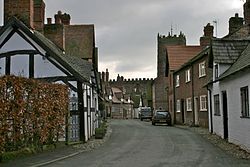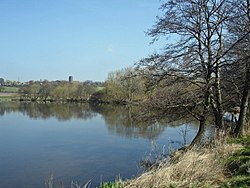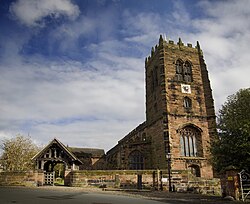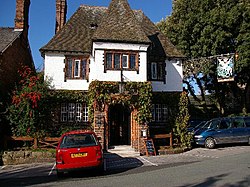Great Budworth
| Great Budworth | |
| Cheshire | |
|---|---|
 The main street | |
| Location | |
| Grid reference: | SJ6677 |
| Location: | 53°17’38"N, 2°30’18"W |
| Data | |
| Population: | 339 (2011[1]) |
| Post town: | Northwich |
| Postcode: | CW9 |
| Dialling code: | 01606 |
| Local Government | |
| Council: | Cheshire West & Chester |
Great Budworth is a village and parish in Cheshire, four miles north of Northwich off the A559 road, east of Comberbach, north-west of Higher Marston and south-east of Budworth Heath. Until 1948, Great Budworth was part of the Arley Hall estate.
Contents
Etymology
According to Sir Peter Leycester, the name Great Budworth comes from the Old Saxon words bode ("dwelling") and wurth ("a place by water").[2]
Geography
Great Budworth is approached from the main Warrington to Northwich road about two miles from Northwich, along a ridge overlooking two meres, Budworth to the west and Pickmere to the east.[3]
The village itself lies in Bucklow Hundred, but the ancient parish extends into Eddisbury and Northwich Hundreds. At 15 miles in length and 10 miles in width, it was considered to be the second largest parish in Cheshire, after Prestbury. The ancient parish comprises nineteen townships: Budworth, Anderton, Appleton-cum-Hull, Aston-juxta-Budworth, Barnton, Barterton, or Bartington, Cogfoall, Comberbach, Dutton, Little-Leigh, Marbury, Marston, Pickmere, Stretton, Nether-Tabley, Over-Witley, Nether Witley, and Wincham.[4]
History
The early history of Great Budworth is documented in the Domesday Book, which mentions a priest at Great Budworth.[5] In 1130, St Mary and All Saints Church was given to the Augustinian canon of Norton Priory[6] by William FitzNigel, Constable of Chester and Baron of Halton.
The lord of the manor during the reign of Henry III was Geoffrey de Dutton. He donated to Norton Priory a third of his land to endow masses for his soul.[7] After the dissolution of the monasteries, King Henry VIII granted the estate to John Grimsditch. It was afterwards divided into several parcels.[4]
There may have been a school in Great Budworth as early as 1563, but certainly one existed by 1578.[8] For centuries, the village was owned by the head of Arley Hall who would collect rent from the villagers.[9] Rowland Egerton-Warburton of Arley Hall paid for restorations and improvements to the church in the 1850s.[10] Egerton-Warburton also undertook a "campaign to render it (the village) picturesque in Victorian eyes".[11] To this end he commissioned architects including William Nesfield and John Douglas to work on buildings in the village.[12] Douglas remodelled the George and Dragon inn in 1875,[13] and restored some of the cottages.[14]
A running pump was the only source of drinking water for the whole community until 1934 when a piped supply was first connected. Until 1948, Great Budworth was part of the Arley Hall estate.[15]
Notable landmarks
The Grade-I-listed St Mary and All Saints Church is in the village. The village is a popular location for films and television including Cluedo[9] and more recently a NatWest advert. Arley Hall, a historic house, is nearby.[9] Also of note in the area are the George and Dragon and Cock o' Budworth public houses,[9] 54–57 High Street, Dene Cottages, Goldmine House and Belmont Hall.
St Mary and All Saints' Church
St Mary and All Saints' Church is recorded as a designated Grade-I listed building.[16] It is an active Anglican parish church in the diocese of Chester, the archdeaconry of Chester and the deanery of Great Budworth.[17] Clifton-Taylor includes it in his list of best English parish churches.[18] Richards describes it as "one of the finest examples of ecclesiastical architecture remaining in Cheshire".[19] The architectural historian Nikolaus Pevsner considered it to be "one of the most satisfactory Perpendicular churches in Cheshire".[20] In the north chapel is a memorial to Sir Peter Leicester, the 17th-century historian, and in the Warburton Chapel is the alabaster effigy of Sir John Warburton who died in 1575.[19] In the north chapel is an organ designed by Samuel Renn, installed in 1839.
Houses
Goldmine House and its attached cottage (Rose Cottage), designated as a Grade-II listed building,[21] were built in 1870 for Rowland Egerton-Warburton of Arley Hall and were designed by the Chester architect John Douglas.[22] Built with brown brick with some timber framing, and clay tile roofs the house faces west. It is a double storied building with two gabled bays. The cottage is simple in form with a dormer and blue brick diapering.[21]
Dene Cottages, a Grade-II-listed pair of cottages, were built in 1867–68, again for Rowland Egerton-Warburton and by Douglas.[23] The lower storeys are constructed in brown brick. The upper storeys are timber-framed with plaster panels. The roof is in clay tiles. The plaster panels are pargetted with floral motifs.[24]
Belmont Hall in this parish was built by J. H. Smith-Barry Esq., who deposited in it his valuable collection of pictures and statues, afterwards removed to Marbury. Smith-Barry sold it to Henry Clarke.[4] Built in 1755 and designed by James Gibbs, it is a Grade I listed building.[25] As of 2014 it is occupied by Cransley School.[26]
George and Dragon pub
The George and Dragon pub, another Grade-II-listed building,[27] was initially built as a simple three-bay Georgian inn. In 1875, John Douglas was commissioned to restore it by Egerton-Warburton. He added tall rubbed chimneys, mullioned windows and a steep pyramidal turret.[28] The double-storied inn has bays built in brick with a roughcast rendering on the upper storey. It has clay tiled covered hipped roofs. Its other architectural features comprise a projecting two-storey porch with oak post-and-rail fence inscribed with a number of sayings on either side, lateral bay with four-light mullioned window in the lower storey and a three-light mullioned window in the upper storey, a tall rubbed brick chimneystack, and the inn sign located diagonally from the right corner.[27][28] The inn continues to function as a public house and restaurant.[29]
54–57 High Street
54–57 High Street is a row of four Grade-II-listed[30] dwellings in the High Street, built in the early 18th century.[30] They were refaced and partly rebuilt for Rowland Egerton-Warburton of Arley Hall by John Douglas in 1870 or 1875.[27][31] The two outer buildings are houses and the two central buildings are cottages. They are built in brown brick with clay tile roofs, and have two storeys plus attics. Each building has a gable, those on the outer buildings larger than those on the inner, all decorated with brick and plaster.[30]
Flora and fauna
In the Middle Ages, Budworth Mere was used as a fish hatchery. Stocked with bream and pike, its reeds shelter breeding reed warblers and great crested grebes.[32] Other avifauna includes mallards and coots.[15]
Culture
The Soul Cakers Play is a seasonal folk play performed in the village every November which brings together the whole community. It features Saint George, the Black Knight and a Hobby Horse.[15] In Great Budworth, the "soul cake" may be a glass of beer or other sustenance; into it comes the devil, or Beelzebub, now "Belshy Bob".[33] The High Street and the Church feature in the 2019 BBC adaption of H.G. Wells The War of Worlds.
References
| ("Wikimedia Commons" has material about Great Budworth) |
Citations
- ↑ "Parish population 2011". http://www.neighbourhood.statistics.gov.uk/dissemination/LeadKeyFigures.do?a=7&b=11123883&c=CW9+6HB&d=16&e=62&g=6409029&i=1001x1003x1032x1004&m=0&r=0&s=1432906345214&enc=1. Retrieved 29 May 2015.
- ↑ Green, Henry (1859). Knutsford, its traditions and history: with reminiscences, anecdotes, and notices of the neighbourhood. Smith, Elder, & Co.. p. 13. https://books.google.com/books?id=9hI4AAAAYAAJ&pg=PA13. Retrieved 11 July 2011.
- ↑ The British architect: a journal of architecture and the accessory arts. 1884. pp. 282–. https://books.google.com/books?id=mbcQAQAAMAAJ&pg=PA282. Retrieved 16 July 2011.
- ↑ 4.0 4.1 4.2 Lysons, Daniel (1810). Magna Britannia: being a concise topographical account of the several counties of Great Britain. Containing Cambridgeshire, and the County Palatine of Chester. Cadell. pp. 519–. https://books.google.com/books?id=n8U_AAAAcAAJ&pg=PA519. Retrieved 11 July 2011.
- ↑ Open Domesday Online: (Great) Budworth, accessed February 2019.
- ↑ Greene 2004, p. 67.
- ↑ Lancashire and Cheshire Antiquarian Society (1897). Transactions of the Lancashire and Cheshire Antiquarian Society. pp. 95–. https://books.google.com/books?id=qxy-DMdn3awC&pg=PA95. Retrieved 16 July 2011.
- ↑ Cox, Marjorie; Hopkins, L. A. (1975). A history of Sir John Deane's Grammar School, Northwich, 1557–1908. Manchester University Press ND. p. 52. ISBN 978-0-7190-1282-2. https://books.google.com/books?id=Bn67AAAAIAAJ&pg=PA52. Retrieved 11 July 2011.
- ↑ 9.0 9.1 9.2 9.3 Lambert, Nick (1 July 1996). Cheshire walks with children. Sigma Leisure. p. 72. ISBN 978-1-85058-560-2. https://books.google.com/books?id=y3ZTHzxD-z8C&pg=PA72. Retrieved 11 July 2011.
- ↑ Steele, Robert J. (May 2003), A Brief History of Great Budworth Church, St Mary's and All Saints Church, archived from the original on 23 August 2007, https://web.archive.org/web/20070823195832/http://www.greatbudworthchurch.org/A%20brief%20history.htm, retrieved 9 September 2007
- ↑ Hubbard, p. 92
- ↑ Hubbard, pp. 79–80
- ↑ Hubbard, pp. 92–93, 246
- ↑ Hubbard, pp. 240, 242, 278
- ↑ 15.0 15.1 15.2 Boast, Howard. "History on your doorstep – Great Budworth". Cheshire Magazine. http://www.cc-publishing.co.uk/Archives/gbudworth.html. Retrieved 16 July 2011.
- ↑ National Heritage List 1139156: Church of St Mary and All Saints, Great Budworth
- ↑ "St Mary & All Saints, Great Budworth". Church of England. http://www.achurchnearyou.com/great-budworth-st-mary-all-saints/. Retrieved 1 January 2011.
- ↑ Clifton-Taylor, Alec (1974). English Parish Churches as Work of Art. Batsford. p. 240. ISBN 0-7134-2776-0.
- ↑ 19.0 19.1 Richards, Raymond (1947). Old Cheshire Churches. Batsford. pp. 170–175.
- ↑ Pevsner, Nikolaus; Hubbard, Edward (2003) [1971]. Cheshire. The Buildings of England. Yale University Press. pp. 227–228. ISBN 0-300-09588-0.
- ↑ 21.0 21.1 National Heritage List 1329888: Goldmine House, Rose Cottage, Great Budworth
- ↑ Hubbard, p.278
- ↑ Hubbard, p.240
- ↑ National Heritage List 1329854: Dene Cottages, 1 and 2 Warrington Road, Great Budworth
- ↑ National Heritage List 1139129: Belmont Hall
- ↑ "Cransley School". Cransley School. Archived from the original on 7 June 2008. https://web.archive.org/web/20080607085557/http://www.cransleyschool.org.uk/. Retrieved 16 July 2008.
- ↑ 27.0 27.1 27.2 National Heritage List 1329885: George and Dragon Inn, Great Budworth
- ↑ 28.0 28.1 Hubbard, pp. 92–93
- ↑ "George and Dragon". Onionring. http://www.onionring.co.uk/restaurants/restaurant_info.asp?RID=1536. Retrieved 14 July 2011.
- ↑ 30.0 30.1 30.2 National Heritage List 1139118: Jasmine Cottage, Nos. 55 & 56 and No. 57 High Street, Great Budworth
- ↑ Hubbard, p. 242
- ↑ Darling, Jen (1 April 1988). West Cheshire Walks. Sigma. pp. 73–. ISBN 978-1-85058-111-6. https://books.google.com/books?id=mIBD5PsVg6EC&pg=PA73. Retrieved 16 July 2011.
- ↑ Wright, Peter (1974). The language of British industry. Macmillan. p. 66. https://books.google.com/books?id=uOS0AAAAIAAJ. Retrieved 16 July 2011.
Bibliography
- Boyd, Arnold (1951). A Country Parish: Great Budworth in the county of Chester. Collins. OCLC 221053881.
- Foster, Charles (1999). "The History of the House and the Family". in Albrighton, Tom. Arley Hall and Gardens, Cheshire. Jarrold.
- Greene, J. Patrick (2004). Norton Priory: The Archaeology of a Medieval Religious House. Cambridge University Press. ISBN 978-0-521-60278-5. https://books.google.com/books?id=70PACwvVscEC&pg=PA67.
- Groves, Linden (2004). Historic Parks & Gardens of Cheshire. Landmark. ISBN 1-84306-124-4.
- Hubbard, Edward (1991). The Work of John Douglas. Victorian Society. ISBN 0-901657-16-6.


